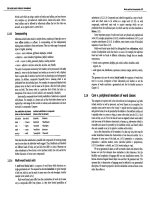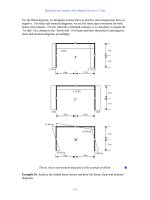Applications of Robotics and Artificial Intelligence Part 7 ppsx
Bạn đang xem bản rút gọn của tài liệu. Xem và tải ngay bản đầy đủ của tài liệu tại đây (29.52 KB, 20 trang )
APPLICATIONS OF ROBOTICS AND ARTIFICIAL INTELLIGENCE
Get any book for free on: www.Abika.com
121
Army experience with computer control,
especially of robot systems.
In the long term, if concurrent
developments in automated tracking using
advanced sensors occur, it may be feasible
to eliminate the gunner, reducing the crew
to a commander and a driver. This would
make possible two-shift operations with two
two-man crews operating and maintaining the
tank over a 24-hour period, a considerable
increase in operating time for very
important equipment. Mechanization of the
ammunition-loading function and an
integrated computer network in place are
prerequisites for this development.
A potential tank of the future could be
unmanned a tank controlled by a
teleoperator from a remote post or hovering
aircraft. The tank would be semiautonomous;
that is, it could maneuver, load rounds,
track targets, and take evasive action to a
limited degree by itself, but its actions
would be supervised by a remote commander
who
would initiate new actions to be carried
out by internally stored computer programs.
Eliminating people on board the tank could
lead to highly improved performance, now
limited by human physical endurance and
APPLICATIONS OF ROBOTICS AND ARTIFICIAL INTELLIGENCE
Get any book for free on: www.Abika.com
122
safety. The tank would become an unmanned
combat vehicle, smaller, lighter, faster,
with far less armor and more maneuverable
essentially a mobile cannon with highly
sophisticated control and target
acquisition systems.
SENTRY/SURVEILLANCE ROBOT
The modern battlefield, as described in Air
Land Battle 2000, will be characterized by
considerable movement, large areas of
operations in a variety of environments,
and the potential use of increasingly
sophisticated and lethal weapons throughout
the area of conflict. Opposing forces will
rarely be engaged in the classical sense
that is, along orderly, distinct lines.
Clear differentiation between rear and
forward areas will not be possible. The
implications are that there will be
insufficient manpower available to observe
and survey the myriad of possible avenues
by which hostile forces and weapons may
threaten friendly forces.
Initially using the concepts and hardware
developed in the Remotely Monitored
Battlefield Sensor System (REMBASS), a
surveillance/ sentry robotic system would
provide a capability to detect intrusion in
specified areas either in remote areas
APPLICATIONS OF ROBOTICS AND ARTIFICIAL INTELLIGENCE
Get any book for free on: www.Abika.com
123
along key routes of communication or on the
perimeter of friendly force emplacements.
Such a system would apply artificial
intelligence technology to integrate data
collected by a variety of sensors seismic,
infrared, acoustic, magnetic, visual, etc
-to facilitate event identification,
recording, and reporting. The device could
also monitor NBC sensors, as well as
operate within an NBC-contaminated area.
Initially, the system would be stationary
but portable, with an antenna on an
elevated mast near a sensor field or
layout. It can build on sentry robots that
are currently available for use in
industry. Ultimately, the system would be
mobile. Either navigation sensors would
provide mobility along predetermined routes
or the vehicle would be airborne; the
decision should be made as the technology
progresses. Also, the mobile system would
employ onboard as well as remote sensors.
Functional Requirements
The proposed initial, portable system would
require
A fully programmable, computer-operated
controller (with transmit/receive
capabilities) that would interface with the
remote sensors and process the sensor data
APPLICATIONS OF ROBOTICS AND ARTIFICIAL INTELLIGENCE
Get any book for free on: www.Abika.com
124
to enable automated recognition (object
detection, identification, and location).
This effort would entail matching the
various VHF radio links from existing or
developmental remote sensors at a "smart"
console to permit integration and
interpretation of the data received.
A secure communications link from the
controller to a tactical operations center
that would permit remote read-out of sensor
data upon command from the tactical
operations center. This communications link
would also provide the tactical operations
center the capability of turning the
controller (or parts of it) on or off.
Later versions of the system would have the
attributes described above, with the
additional features of mobility and onboard
sensors. In this case, the
sentry/surveillance robot would become part
of a teleoperated vehicular platform,
either traversing a programmed, repetitive
route or proceeding in advance of manned
systems to provide early warning of an
enemy presence.
Benefits
The principal near-term advantages are
APPLICATIONS OF ROBOTICS AND ARTIFICIAL INTELLIGENCE
Get any book for free on: www.Abika.com
125
to provide a test bed for exploiting AI
technology in a surveillance/sentry
application, using available sensors
adapted to
special algorithms that would minimize
false alarms and speed up the process of
detection, identification, and location.
to permit a savings in the manpower
required for monitoring sensor alarms and
interpreting readings, while providing 24-
hour-a-day, all-weather coverage.
to provide a capability for operating a
surveillance/sentry system under NBC
conditions or to warn of the presence of
NBC contaminants.
The far-term mobile system would be
invaluable in providing surveillance/sentry
coverage in the vicinity of critical or
sensitive temporary field facilities, such
as high-level headquarters or special
weapons storage areas.
INTELLIGENT MAINTENANCE, DIAGNOSIS, AND
REPAIR SYSTEM
Expert Systems applications in automatic
test equipment (ATE) can range from the
equipment design stage to work in the
field. Expert systems incorporating
APPLICATIONS OF ROBOTICS AND ARTIFICIAL INTELLIGENCE
Get any book for free on: www.Abika.com
126
structural models of pieces of equipment
can be used in equipment design to simplify
subsequent trouble shooting and
maintenance.
In the field, expert systems can guide the
soldier in expedient field repairs. At the
depot, expert systems can perform extensive
diagnosis, guide repair, and help train new
mechanics.
In the diagnostic mode it would instruct
the operator not only in the sequence of
tests and how to run them, but also in the
visual or aural features to look for and
their proper sequence.
In the maintenance mode the system would
describe the sequence of tests or
examinations that should be performed and
what to expect at each step.
In the repair mode the system would guide
the operator on the correct tools, the
precise method of disassembly, the required
replacement parts and assemblies by name
and identification numbers, and the proper
procedure for reassembly. After repair the
maintenance mode can be exercised to ensure
by appropriate tests that repair has, in
fact, been effected without disabling any
other necessary function.
APPLICATIONS OF ROBOTICS AND ARTIFICIAL INTELLIGENCE
Get any book for free on: www.Abika.com
127
In any of the above operations the system
would record the repairs, maintenance
procedures, or conditions experienced by
that piece of equipment. Users would thus
have access to essential readiness
information without needing bulky, hard-to-
maintain maintenance records.
Current Projects and Experience
Some current Army and defense projects
concerned with ATE are
VTRONICS, a set of projects for onboard,
embedded sensing of vehicular malfunctions
with built-in test equipment (BITE);
VIMAD, Voice Interactive Maintenance Aiding
Device, which is external to the vehicle;
Hawk missile computer-aided instruction for
maintenance and repair.
Electronic malfunctions have been the
subject of the most research, and
electronics is now the most reliable aspect
of the systems. Not much work has been done
to reduce mechanical or software
malfunctions. During wartime, however, such
systems will need to be survivable under
fire as well as be reliable under normal
conditions.
APPLICATIONS OF ROBOTICS AND ARTIFICIAL INTELLIGENCE
Get any book for free on: www.Abika.com
128
For ground combat vehicles around 1990, a
BITE diagnostic capability to tell the
status of the vehicle power train is
planned. In one development power train
system, the critical information is
normally portrayed either by cues via a
series of gauges or by a digital readout.
Malfunctions can be diagnosed through these
cues and displays. The individual is
prompted to push buttons to go through a
sequence of displays.
An existing Army project concerns a
helicopter cockpit display diagnostic
system. One purpose of the project was to
study audible information versus visual
display. For example, the response to the
FUEL command is to state the amount of fuel
or flying time left; the AMMO command tells
the operator how much ammunition is left.
One reason for using speech output is that
monitoring visual displays distracts
attention from flying.
A lot of work has been done in the Army on
maintenance and repair training, but
computer-assisted instruction (CAI) and
artificial intelligence could greatly
reduce training time. For example, the Ml
tank requires 60,000 pages of technical
manuals to describe how to repair
breakdowns.
APPLICATIONS OF ROBOTICS AND ARTIFICIAL INTELLIGENCE
Get any book for free on: www.Abika.com
129
The Army has planned for an AI maintenance
tutor that would become a maintenance aid,
but it is not yet funded. Under the VIMAD
project supported by DARPA, a helmet with a
small television receiver optically linked
to a cathode ray tube (CRT) screen is being
investigated as an aid to maintenance.
Computer-generated video disk information
is relayed.
An individual working inside the turret of
an Ml tank, for example, cannot at present
easily flip through the pages of the repair
manual. With VIMAD, using a transmitter,
receiver, floppy disk, and voice
recognition capability, the individual can
converse with the system to get information
from the data base. The system allows a 19-
word vocabulary for each of three
individuals. The system has a
100-word capability to access more
information from the main system and
provides a combination of audio cues and
visual prompts.
Any Army diagnostic system should be easily
understood by any operator, regardless of
maintenance background ("user friendly").
Choosing from alternatives presented in a
menu approach, for example, is not
necessarily easy for a semiliterate person.
APPLICATIONS OF ROBOTICS AND ARTIFICIAL INTELLIGENCE
Get any book for free on: www.Abika.com
130
We propose that the following projects be
supported as soon as possible:
Interactive, mixed-media manuals for
training and repair. Manuals should employ
state-of-the-art video disk and display
technology. The MIT Arcmac project,
supported by the Office of Naval Research,
illustrates this approach.
Development of expert systems to trouble-
shoot the 50 to 100 most common failures of
important pieces of equipment. The system
should incorporate simple diagnostic cues,
be capable of fixed format (stylized,
nonnatural) interaction, and emphasize
quick fixes to operational machinery. The
project should be oriented toward
mechanical devices to complement the
substantial array of existing electronic
ATE. Projects in this category should be
ready for operational use by
1987.
Longer-term development of expert systems
for ATE of more complex mechanical and
electromechanical equipment. The systems in
this category are intended for use at
depots near battle lines. They are less
oriented to quick fixes and incorporate
preventive maintenance with more
intelligent trouble shooting. They do not
APPLICATIONS OF ROBOTICS AND ARTIFICIAL INTELLIGENCE
Get any book for free on: www.Abika.com
131
aim for the sophisticated expertise of a
highly qualified technician or mechanic.
The emphasis is on (1) determining whether
it is feasible to fix this piece of
equipment, (2) determining how long it will
take to fix, (3) determining if limited
resources would be better used to fix other
pieces of equipment, and (4) laying out a
suitable process for fixing the equipment.
The trouble-shooting systems recommended
above rely on human sensors, exactly like
MYCIN and Prospector. MYCIN is an expert
system for diagnosing and treating
infectious diseases that was developed at
Stanford University. Prospector, developed
at SRI International, is an expert system
to aid in exploration for minerals.
Parallel, longer-term efforts should be
started to incorporate automatic sensors
into the trouble-shooting expert systems
recommended above.
EXPERT SYSTEMS FOR ARMY MEDICAL
APPLICATIONS
Expert systems for various areas of
medicine are being extensively studied at a
number of institutions in the United
States. These include
rule-based systems at Stanford (MYCIN) and
Rutgers (for glaucoma) ,
APPLICATIONS OF ROBOTICS AND ARTIFICIAL INTELLIGENCE
Get any book for free on: www.Abika.com
132
Bayesian statistical systems (for computer-
assisted diagnosis of abdominal pain),
cognitive model systems (for internal
medicine, nephrology, and cholestasis) ,
knowledge management systems for diagnosis
of neurological problems at Maryland.
Current Army activities to apply robotics
and artificial intelligence in the medical
area are described in the Army Medical
Department's AI/Robotics plan, which was
prepared with the help of the Academy of
Health Sciences, San Antonio. This plan was
presented to this committee by the U.S.
Army Medical Research and Development
Command (AMRDC).
Current Army Activities
Purdue University's Bioengineering
Laboratory has an Army contract to study
the concept of a "dog-tag chip" that will
assist identification of injured personnel.
The goal for this device is to assist in
the display of patient symptoms for rapid
casualty identification and triage. AMRDC
noted that visual identification of
casualties in chemical and biological
warfare may be very difficult because of
the heavy duty garb that will be worn.
APPLICATIONS OF ROBOTICS AND ARTIFICIAL INTELLIGENCE
Get any book for free on: www.Abika.com
133
Airborne or other remote interrogation of
the dog-tag chip, its use in self-aid and
buddy-aid modes, and use of logic trees on
the chip for chemical warfare casualties
are being examined by the Army. Other areas
of AI and robotics listed in the U.S. AMRDC
plan are training, systems for increased
realism, and a "smart aideman" expert
system, the latter being a "pure"
application of expert systems to assist in
early diagnosis.
Medical Environments, Functions, and
Payoffs Medical environments likely to be
encountered in the Army are
routine nonbattle, general illnesses, and
disease;
battle injuries, shock/trauma;
epidemics;
chemical;
radiation;
bacteriological.
In a battle area, a medical diagnosis
paramedic aide machine would
APPLICATIONS OF ROBOTICS AND ARTIFICIAL INTELLIGENCE
Get any book for free on: www.Abika.com
134
speed up diagnosis by paramedic and provide
productivity increase, noninvasive sensing,
and triage;
suggest the best drugs to give for a
condition, subject to patient allergies;
suggest priority, disposition, and radio
sensor signals on a radio link to field
hospital, if necessary to consult
physician.
At forward aid stations, in addition to
routine diagnostic help, the device might
infer patterns of illness on the basis of
reports from local areas, track patient
condition over time, and teach paramedics
the nature of conditions occurring in that
particular area that may differ from their
prior experience.
Payoffs would include increasing soldiers'
likelihood of survival and the consequent
boost to morale through the knowledge that
efforts
to save them were being assisted by the
latest technology. Note that the automated
battalion information management system,
described below, will involve building a
large planning model, which could include
medicine.
APPLICATIONS OF ROBOTICS AND ARTIFICIAL INTELLIGENCE
Get any book for free on: www.Abika.com
135
Recommended Medical Expert Systems
In view of existing technology, a more
aggressive dog-tag chip program than that
already under way at Purdue University is
advocated. The Army should contract with
some commercial company currently making
wristwatch monitors to develop a
demonstration model Army body monitor and
not worry if the development gets out into
the public domain. Wristwatch monitors of
pulse rate, temperatures, etc., are listed
in catalogs such as the one from Edmund
Scientific.
Technology for low-level digital
communication with cryptography is also
available. As a prerequisite to the smart
dog-tag, the Army may wish to make use of
this technology in various Army systems
more mundane than the smart dog-tag chip.
Cryptography can ensure that information on
a smart dog-tag is not susceptible to
interception.
Collection of data on noninvasive new and
old sensors and related methods of
statistical analysis to determine their
efficiency in monitoring casualty/injury
conditions should be the subject of a
longer term study. The study should create
APPLICATIONS OF ROBOTICS AND ARTIFICIAL INTELLIGENCE
Get any book for free on: www.Abika.com
136
a data base that relates medical diagnosis
and sensor capabilities.
The development of AI expert systems aimed
at providing computer consulting for
nonbattle and battle-area Army medicine and
paramedical training are long-term projects
that could be undertaken in collaboration
with military and university hospitals. For
example, the emergency room or shock/trauma
unit of a civilian hospital could be used
in beginning studies. Correlation of the
patient 's current condition with past
medical history as recorded on a soldier's
dog-tag chip would be one result available
from an expert system. Paramedic skills may
or may not require a slight increase,
depending on how well the AI
aid is designed. It does seem that the same
number of paramedics should be able to
accomplish more.
FLEXIBLE MATERIAL-HANDLING MODULES
Most robot applications in industry today
are directly related to material handling.
These include loading and unloading
machines, palletizing, feeding parts for
other automation equipment, and presenting
parts for inspection.
APPLICATIONS OF ROBOTICS AND ARTIFICIAL INTELLIGENCE
Get any book for free on: www.Abika.com
137
Material handling in Army operations has
many similar applications, which, at the
very least, involve a great number of
repetitive operations and often require
working under hazardous conditions. It is
proposed to make use of state-of-the-art
robotics to develop a
multifunctional, material-handling robotic
module that can be readily adapted for many
Army functions serving both rear echelon
and front line supply needs.
An ammunition resupply robot could select,
prepare, acquire, move, load, or unload
ammunition at forward weapon sites to
reduce exposure of personnel or in rear
storage areas to reduce personnel
requirements and provide 24-hour
capability.
For general use, a robot mounted on a
wheeled base is recommended so that the
human operator can maneuver the robot into
position and then initiate a stored
computer program that it will execute
without continuous supervision. With
present technology constraints on the
necessary vision system, it would be
necessary to have a bar-code identifying
insignia affixed to every package or object
in a known position. State-of-the-art
APPLICATIONS OF ROBOTICS AND ARTIFICIAL INTELLIGENCE
Get any book for free on: www.Abika.com
138
pattern recognition devices can then be
mounted on the robot arm to identify an
object or package for sorting and
verification. Future technological advance
would reduce the need for identifying
insignia.
The proposed robot to refuel vehicles is
actually an instance of a material-handling
module. It would be mounted on wheels and
equipped with vision. The operator would
position the robot in the proximate
location, where it would then use a fuel
dispenser without exposing the crew.
Special gas tank caps would be required to
facilitate insertion and dispensing of fuel
by the robot.
Functional Requirements
The module would be a fully programmable,
servo-driven robot with advanced controller
capable of interfacing with a vision
module, other sensor modules, and
teleoperator control. It would include a
teach-box programmer to provide the
simplest programming capability by unit-
level nonspecialists. The teleoperator
would provide the operator with the ability
to operate the robot on one-at-a-time tasks
that do not require repetitive operations
APPLICATIONS OF ROBOTICS AND ARTIFICIAL INTELLIGENCE
Get any book for free on: www.Abika.com
139
or are too difficult to program for
automatic operation.
The robot module base would be designed to
be readily mounted on a truck, a trailer,
or a weapons carrier, or emplaced on a
rigid pad or even firmly embedded in the
ground. It would be desirable to engineer
several different sizes with different load
capacities but operating with identical
controllers.
High speed and precision would be desirable
but not mandatory. Trade-offs for
ruggedness, simplicity, maintainability,
and cost should be considered seriously.
Provision would be made for readily
interchangeable end effectors, or "hands."
Each application would have a specialized
end effector, which could be a gripper or
tool. The particular requirements of the
task or mission would specify which set of
effectors accompany the robot.
Some near-term advantages are
In supply logistics the module could stack
such items as packages or ammunition, from
either trucks or supply depots, where
standard pallet operations are not
available or feasible. Many personnel
engaged in all forms of moving supplies and
APPLICATIONS OF ROBOTICS AND ARTIFICIAL INTELLIGENCE
Get any book for free on: www.Abika.com
140
munitions would become acquainted with and
adept at the use of this strength-
enhancing, labor-saving tool. Reduction of
staff and elimination of many repetitive
and fatiguing operations would result. Key
personnel would be time-shared, since a
single operator could set up and supervise
several robot systems.
In front line and other hazardous
activities, the robot module, after
programming, could operate autonomously or
under supervisory control from a safe
location. Ammunition and fuel resupply for
tanks serviced by a robot mounted on a
protected vehicle is a typical example.
Handling hazardous chemical or nuclear
objects or material could be performed
remotely. Retrieving and delivering objects
under fire may be possible with appropriate
remote-controlled vehicles.
When personnel become familiar and
experienced with these systems, they will
probably generate and jury-rig a robot to
perform new operations creatively. This
system is meant to be a general-purpose
helper.
The long-range advantages include the
following:









